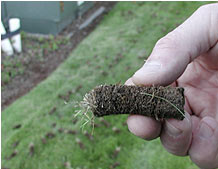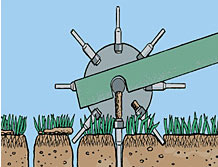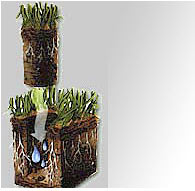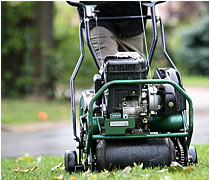Why Should You Aerate Your Lawn?
Control Thatch Layer Development
 As your lawn grows, it can accumulate a thick layer of thatch on the surface of the soil. Thatch consists of a tight network of roots, rhizomes and/or stolons and looks like a thick fiberous mat. This thatch layer acts as a barrier, blocking the movement of air, water and fertilizers into the root zone.
As your lawn grows, it can accumulate a thick layer of thatch on the surface of the soil. Thatch consists of a tight network of roots, rhizomes and/or stolons and looks like a thick fiberous mat. This thatch layer acts as a barrier, blocking the movement of air, water and fertilizers into the root zone.
By aerating your lawn annually the thatch layer is routinely broken up and the soil cores that are pulled up break apart on the lawn surface mixing with the thatch modifying it into something closer to soil than thatch. The soil cores are also full of microorganisms that help to accelerate the decomposition of the thatch layer.
Reduce Insect & Disease Incidence
The thatch layer is the perfect environment  for disease organisms, and insect pests. Chinch bugs thrive in a thick thatch layer, and a variety of pathogenic turfgrass fungi can be found within a thatch layer. By keeping your thatch layer to a minimum you will reduce turf damage from insects and disease without the use of any pesticides.
for disease organisms, and insect pests. Chinch bugs thrive in a thick thatch layer, and a variety of pathogenic turfgrass fungi can be found within a thatch layer. By keeping your thatch layer to a minimum you will reduce turf damage from insects and disease without the use of any pesticides.
Reduce Soil Compaction
Thatch accumulation can also be dramatically accelerated when the soil of a lawn is compacted. A compact soil results in the water and fertilizers sitting on the surface of soil, and this causes the roots, rhizomes and stolons of the lawn to grow on the surface, rapidly creating a thatch layer problem. Core aeration breaks up compacted soil allowing water, fertilizer and air to penetrate deep which results in deep rooting of the lawn.
More Efficient Irrigation
Compacted soils or a thick thatch layer inhibit the penetration of the water into the soil. Thatch layers can become hydrophobic, repelling water and making it almost impossible to get water down into the root zone. On compacted or thatched lawns that have a slope, irrigation water just runs down the slope rather than entering the soil. Aeration opens up the soil and allows irrigation water to penetrate deep into the root zone rather than running down the hill or into the storm sewer.
Summer Drought Damage
 In a lawn with a compacted soil, most of the root growth occurs close to the surface, and this creates a lawn that is highly susceptible to summer drought. Aeration opens up the soil so water, fertilizers and air can penetrate deep, encouraging roots to grow deep, resulting in a lawn better able to tolerate the periods of summer drought.
In a lawn with a compacted soil, most of the root growth occurs close to the surface, and this creates a lawn that is highly susceptible to summer drought. Aeration opens up the soil so water, fertilizers and air can penetrate deep, encouraging roots to grow deep, resulting in a lawn better able to tolerate the periods of summer drought.
Improve the Results of Insect Control Applications
If you have root feeding insects in your lawn,  like European Chafer (white grub), then it is important to keep your thatch layer to a minimum. Insect control products can become trapped in the thatch layer and fail to get down into the root zone where the insects are feeding. This results in poor insect control that generally translates into turf damage.
like European Chafer (white grub), then it is important to keep your thatch layer to a minimum. Insect control products can become trapped in the thatch layer and fail to get down into the root zone where the insects are feeding. This results in poor insect control that generally translates into turf damage.
Reduce the Incidence of Weeds
 Many weeds can tolerate compacted soils better than turfgrass. If your lawn is compacted it can result in an environment that is more conducive to weed growth than turfgrass growth. By aerating a lawn and alleviating any soil compaction, the weeds that perform well in compacted soil lose the competitive advantage and the turfgrass thrives.Normally, an annual aeration is sufficient for good healthy turf. Heavily compacted soils may require additional aeration. Our turf specialist can advise you on what is needed for your lawn.Your lawn must have adequate moisture content in order for aeration to be effective, so we may ask you to water in advance of aerating if seasonal conditions make it necessary. The aeration process will leave plugs of thatch and soil on the lawn but these will decompose in a few weeks. Mow and water your lawn normally.
Many weeds can tolerate compacted soils better than turfgrass. If your lawn is compacted it can result in an environment that is more conducive to weed growth than turfgrass growth. By aerating a lawn and alleviating any soil compaction, the weeds that perform well in compacted soil lose the competitive advantage and the turfgrass thrives.Normally, an annual aeration is sufficient for good healthy turf. Heavily compacted soils may require additional aeration. Our turf specialist can advise you on what is needed for your lawn.Your lawn must have adequate moisture content in order for aeration to be effective, so we may ask you to water in advance of aerating if seasonal conditions make it necessary. The aeration process will leave plugs of thatch and soil on the lawn but these will decompose in a few weeks. Mow and water your lawn normally.